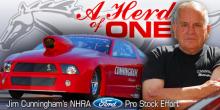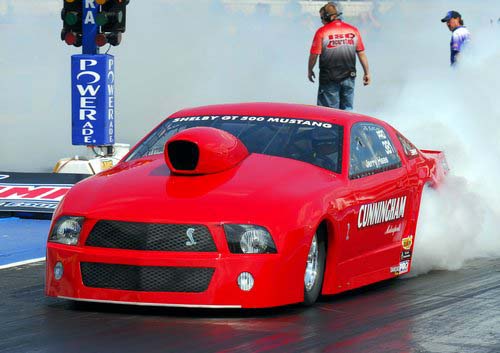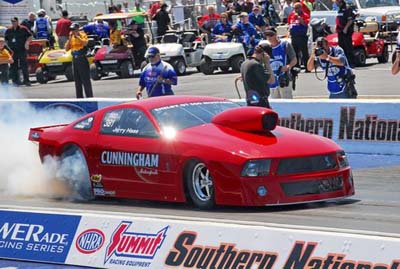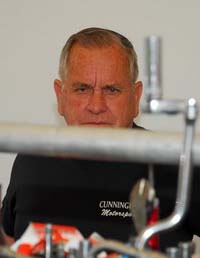JIM CUNNINGHAM - BLUE OVAL PROUD
 It used to be different. Very different.
It used to be different. Very different.Long before the dominance of General Motors and drivers Greg Anderson, Warren Johnson, Jason Line, and Jeg Coughlin, and to a lesser extent, Mopar and Darrell Alderman, Ford carried the biggest stick in NHRA Pro Stock, and the man who wielded that stick with deadly efficiency was Bob Glidden.
The quiet man from Indiana won an unprecedented 10 NHRA championships in 16 years, including five consecutive titles from 1985 to 1989, and amassed 85 national event victories before retiring at the end of the 1997 season. In the summer of 1978, he embarked on a remarkable winning streak that included nine straight national event victories. He qualified No. 1 at a record 23 consecutive races, including all 14 events in 1987.
The glory days for fans of the Blue Oval were doomed to be short-lived, however. Glidden’s retirement and Ford’s exodus from NHRA Pro Stock racing dealt the class a one-two punch from which it never recovered. Long-suffering GM and Mopar supporters, who had had nothing to cheer about since the late Lee Shepherd took his Camaro to four titles between 1981 and 1984, weren’t sad to see Ford go.
One man’s quest to make Ford a player in NHRA Pro Stock again

It used to be different. Very different.

The quiet man from Indiana won an unprecedented 10 NHRA championships in 16 years, including five consecutive titles from 1985 to 1989, and amassed 85 national event victories before retiring at the end of the 1997 season. In the summer of 1978, he embarked on a remarkable winning streak that included nine straight national event victories. He qualified No. 1 at a record 23 consecutive races, including all 14 events in 1987.
The glory days for fans of the Blue Oval were doomed to be short-lived, however. Glidden’s retirement and Ford’s exodus from NHRA Pro Stock racing dealt the class a one-two punch from which it never recovered. Long-suffering GM and Mopar supporters, who had had nothing to cheer about since the late Lee Shepherd took his Camaro to four titles between 1981 and 1984, weren’t sad to see Ford go.
But they should have been, because the class has never been the same since.
Standing in stark testimony to this is the fact that only two drivers since Glidden have qualified a Ford for an NHRA Pro Stock field.
The most recent was the late Vince Fourcade, who accomplished the feat at Las Vegas in 2004. But it was the late Scott Geoffrion who has been the only one to place in the championship points with a No. 10 finish in 2004.
Other than that, the Ford qualifying success has been limited to say the least. Others have tried to resurrect Ford’s glory days in the ranks of the “factory hot rods,” but without backing from Dearborn, all have found the task overwhelming.
And that includes Jim Cunningham. Hopefully, however, all of that is about to change. Cunningham is stubbornly loyal to the Ford brand, and to NHRA Pro Stock racing, and he is determined that the next time he knocks and someone from GM or Mopar peeks out, he’ll jam his foot in the door.
a d v e r t i s e m e n t
Click to visit our sponsor's website
 At 70, an age at which most drivers have long since hung up their
helmets in favor of more benign pursuits, Cunningham has embarked upon a
one-man quest to bring respectability back to the Ford badge,
NHRA-Pro-Stock-wise.
At 70, an age at which most drivers have long since hung up their
helmets in favor of more benign pursuits, Cunningham has embarked upon a
one-man quest to bring respectability back to the Ford badge,
NHRA-Pro-Stock-wise.
Cunningham’s journey actually began in 1999 when he made the decision to go Pro Stock racing and commissioned chassis builder Jerry Haas to construct a 2000 Mercury Cougar, the first carbon fiber-bodied car seen in the category. In 2004, Cunningham added a Ford Escort to his stable, and he later replaced the Cougar with a second Escort, this one driven by nephew Josh King.
Cunningham spent a lot of money and put in long, frustrating hours
in the shop and on the track, but he eventually had to face the reality of the
situation. The direction he had been going in just wasn't the right one. He had
good cars, but he wasn't making the horsepower he needed to be competitive. In
seven seasons neither of his cars made it into a national event field.
Enough was enough as far as Cunningham was concerned. Imbued with a never-say-die spirit, the energetic veteran competitor took stock of his circumstances, and forged ahead with a plan that he hoped would reverse his fortunes. He decided that he needed to take charge of his own destiny, and in the Pro Stock world that means building your own engines.
In 2005, Cunningham constructed a shop on the grounds of Capitol Raceway in Crownsville, Maryland, a facility that he has owned since 1974. In September of that year he hired Tom Sweeny to oversee the new engine program and to serve as crew chief for the Cunningham Motorsports team.
Owning a race track has distinct advantages, as Sweeny pointed out. “We are the only team in the NHRA that has a full quarter-mile drag strip right outside the door,” he said. “It's less than 100 yards away from the shop and we plan to take every opportunity to use that to our advantage. It's something that Jim has never done in the past, but it's something that we are definitely going to do now.”
Sweeny worked for Cunningham on a part-time basis until retiring from his career as a firefighter in July 2006. Once Sweeny was involved full-time, the next man to join the team was Jamie Seger, who had the unenviable but potentially satisfying task of developing a new Ford Pro Stock engine program from the ground up.
“We took a look at what we had and decided that if we were going to make it work we needed quite a few new components,” Sweeny said. “We spent a considerable amount of money buying new blocks from Ford, and we got new head castings from them as well. They are the same E460 heads used in the past, but they are new castings. Once we had the new heads, we started working with some people in North Carolina to develop a port package and a valve train package. Of course, I can’t mention any of their names.”
Was all of this really necessary? That same thought occurred to Sweeny when Cunningham first approached him about coming to work with him. “Jim was complaining about the fact that he’d spent a lot of money and was not able to qualify,” Sweeny said. “I asked him if he was set on running a Ford because for the money he was spending we could have put him in a GM product and leased a motor for a year and more than likely he would have had a car that would qualify.
“His answer was an emphatic ‘no - it's got to be a Ford and it's got to be in NHRA.’ That's what he wants, so we put the shop together and filled it with the latest state-of-the-art CNC equipment. We got the best we could get for what we wanted to do. Now, 18 months later, we're very close to the point where we can test the first of our new engines.”
a d v e r t i s e m e n t
| {flashembed}swf=/images/banners/flashBanner/reherad2.swf|w=468|h=60{/flashembed} |
Click to visit our sponsor's website

“We’re coming back and our goal is to qualify,” said Sweeny. “We want to put a Ford in the program; we want to be the first to do it since Scott Geoffrion did it when he was driving for Hurley Blakeney at Gainesville in 2003. Robert Patrick tried it for years - he put a lot of money into it after Bob Glidden left the Ford program, but he could never make it happen. He’s doing real well in the IHRA these days, though, so now it’s Jim’s turn to try and make an impact in NHRA.”
Speaking of Glidden, it’s been rumored that Cunningham was planning to join forces with the past master of Ford Pro Stock competition.
“I talk to Bob all the time,” Cunningham said. “We are good friends. I don’t think he really knows what he wants to do. He’s a good guy and a workaholic. Someday it might happen. You never know. He needs to be out there whether it is with me or someone else. I have tried to get him to come out here, so I can learn some of his knowledge. He’s a smart man.”
There are other smart men in the sport, however, and one of them has recently joined Cunningham Motorsports. Marcus Bowen, former crew chief for Mark Pawuk, is now helping turn wrenches on Cunningham’s Mustang.
“We were very pleased to have Marcus join our team,” Sweeny said. “He adds a lot of expertise to our program, especially when it comes to tuning. He has a ton of experience. He's always been with good teams - he's no slouch.”
So the new car has made its first runs, and the first of the new engines is scheduled to come off the dyno in Maryland any day now. Maybe, just maybe, Ford fans might have something to cheer about before too many more races are in the books. Do they dare take the dream one step further? Will they ever see factory-backed Fords on the track again?
If Cunningham and Sweeny have their way, it just might happen.
a d v e r t i s e m e n t
| {flashembed}swf=/images/banners/flashBanner/ramad5.swf|w=468|h=60{/flashembed} |
Click to visit our sponsor's website
 “We've gotten a lot of cooperation from Tom Detloff at Ford
Performance Racing Products, which is a part of the Ford Motor Company,” Sweeny
said. “We purchased our blocks and cylinder head castings from them, and
they’ve given us a lot of support. Right now, there’s not a whole lot of incentive for Ford
to get back into NHRA Pro Stock, because we’re the only team out there right
now. They’re not inclined to spend the
kind of money it would take to re-engineer a new block, or develop new heads
such as GM and Mopar have done. We’re
hoping we can prove that we can make this stuff competitive, and show them that
there are people out there who want to run Fords. Maybe that will make it more
financially viable for Ford to get back involved and help us with the
engineering. Hopefully we can prove to them it is a viable option for them and
they will come on board.
“We've gotten a lot of cooperation from Tom Detloff at Ford
Performance Racing Products, which is a part of the Ford Motor Company,” Sweeny
said. “We purchased our blocks and cylinder head castings from them, and
they’ve given us a lot of support. Right now, there’s not a whole lot of incentive for Ford
to get back into NHRA Pro Stock, because we’re the only team out there right
now. They’re not inclined to spend the
kind of money it would take to re-engineer a new block, or develop new heads
such as GM and Mopar have done. We’re
hoping we can prove that we can make this stuff competitive, and show them that
there are people out there who want to run Fords. Maybe that will make it more
financially viable for Ford to get back involved and help us with the
engineering. Hopefully we can prove to them it is a viable option for them and
they will come on board.
“There are lots of people out there who would like to run Ford products in NHRA Pro Stock, but since there are no competitive engine programs available, they’re not going to spend money on leasing an engine that they know is not going to get them into the field,” Sweeny said. “They’ll just go to the IHRA and race, which is what Robert Patrick and a bunch of other guys have done. We’re hoping to prove that it is possible to make competitive horsepower with a 500-inch Ford motor in NHRA trim. Once we can do that, we hope to interest people in leasing motors from us. If Ford sees that happening, well, who knows?
“You have to be different,” Cunningham said. “I just like the Ford stuff. Making this car competitive is a big challenge. If we can make it work, we will have accomplished what we set out to do. We’ll get there sooner or later. Sometimes you have to crawl before you can walk.”
{loadposition feedback}



